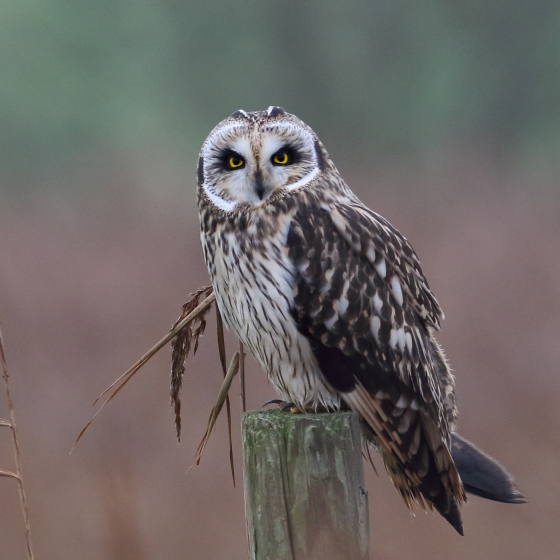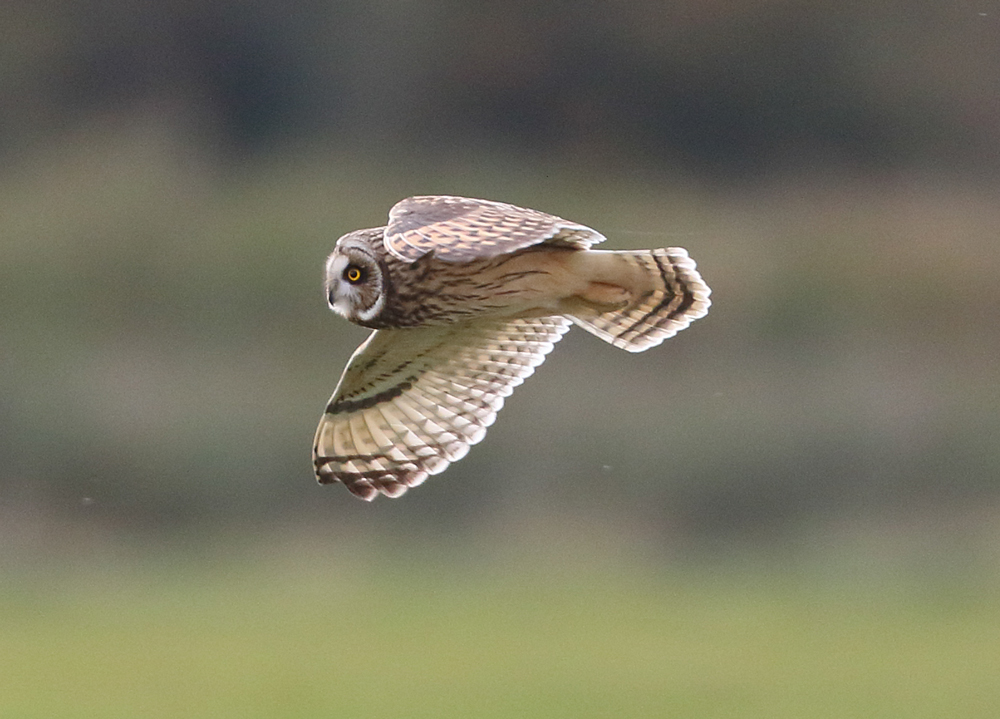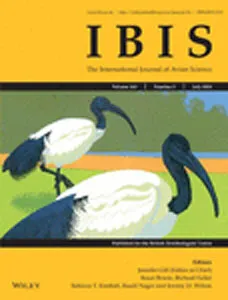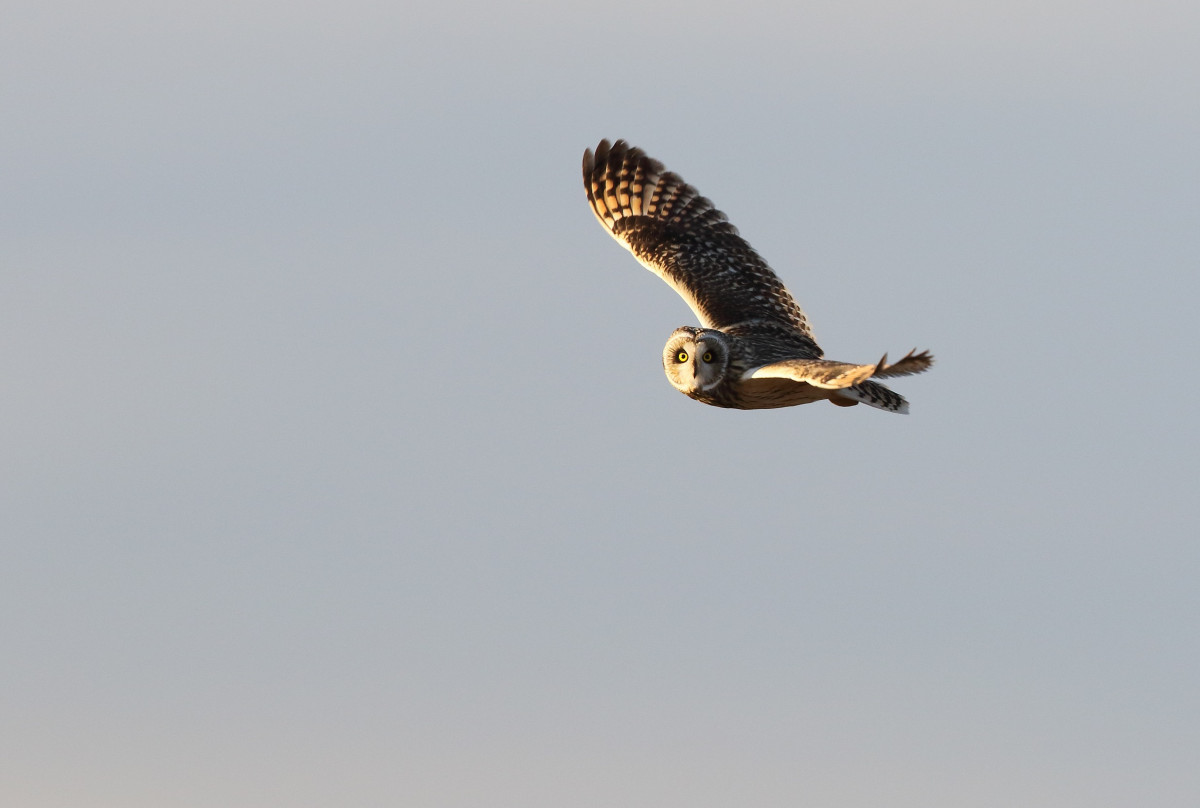Short-eared Owl

Introduction
The Short-eared Owl is associated with upland grassland and young forestry during the breeding season, and with a broader range of grassland habitats in winter.
The Short-eared Owl is a scarce breeding species in Britain & Ireland, and rather nomadic in its habits, breeding in one location one year and moving to a new location entirely the next. Some individuals may even make multiple breeding attempts in widely different locations during the same breeding season.
Short-eared Owls mainly feed on small mammals, with Field Vole of particular importance, and both their breeding distribution and success have been linked to prey availability.

Key Stats
Identification
ID Videos
This section features BTO training videos headlining this species, or featuring it as a potential confusion species.
Short-eared and Long-eared Owls
Songs and Calls
Call:
Status and Trends
Conservation Status
Population Change
The breeding distribution of Short-eared Owl has almost halved since the 1968–72 Breeding Atlas (Balmer et al. 2013), and the species was added to the Rare Breeding Birds Panel list in 2010. The most recent population estimate was 620 to 2,200 pairs (APEP4). The species is a nomadic breeder and recent tracking work by the BTO has shown that one bird made breeding attempts in both Scotland and Norway in the same year; this suggests that individuals birds may have a flexible breeding strategy and breeding numbers in the UK may fluctuate in response to numbers of small mammals.
Distribution
The Short-eared Owl's core breeding range is the open rough country of northern England and Scotland, where they favour heather moorland, rough grassland, bogs and young forestry plantations. Elsewhere breeding records are widely scattered and involve a small number of pairs, in lowland coastal marshes and extensive grasslands. Abundance is greatest on Orkney, on the Uists and in the Pennines. An influx of Fennoscandian breeders boosts wintering numbers, which are widely distributed along the British east coast from Fife to Kent, in large river valleys in southern and eastern England, the lowlands of Lancashire and the downlands of Hampshire and Wiltshire. Irish records are usually along the east coast.
Occupied 10-km squares in UK
or view it on Bird Atlas Mapstore.
or view it on Bird Atlas Mapstore.
European Distribution Map
Distribution Change
Since the 1968–72 Breeding Atlas, the breeding range has almost halved and the species is now Amber-listed in the UK and numbers are monitored by the Rare Breeding Birds Panel.
Change in occupied 10-km squares in the UK
or view it on Bird Atlas Mapstore.
or view it on Bird Atlas Mapstore.
Seasonality
Short-eared Owls are present throughout the year but more often recorded in autumn and winter months when significant arrivals from the continent may swell resident numbers.
Weekly pattern of occurrence
The graph shows when the species is present in the UK, with taller bars indicating a higher likelihood of encountering the species in appropriate regions and habitats.

Movement
Britain & Ireland movement
Foreign locations of birds ringed or recovered in Britain & Ireland
Dots show the foreign destinations of birds ringed in Britain & Ireland, and the origins of birds ringed overseas that were subsequently recaptured, resighted or found dead in Britain & Ireland. Dot colours indicate the time of year that the species was present at the location.
- Winter (Nov-Feb)
- Spring (Mar-Apr)
- Summer (May-Jul)
- Autumn (Aug-Oct)

European movements
EuroBirdPortal uses birdwatcher's records, such as those logged in BirdTrack to map the flows of birds as they arrive and depart Europe. See maps for this species here.
The Eurasian-African Migration Atlas shows movements of individual birds ringed or recovered in Europe. See maps for this species here.
Biology
Productivity and Nesting
Nesting timing
Egg measurements
Clutch Size
Incubation
Survival and Longevity
Survival is shown as the proportion of birds surviving from one year to the next and is derived from bird ringing data. It can also be used to estimate how long birds typically live.
View number ringed each year in the Online Ringing Report.
lifespan
Biometrics
Wing length and body weights are from live birds (source).
Ring Size
Classification, names and codes
Classification and Codes
- Order: Strigiformes
- Family: Strigidae
- Scientific name: Asio flammeus
- Authority: Pontoppidan, 1763
- BTO 2-letter code: SE
- BTO 5-letter code: SHEOW
- Euring code number: 7680
Alternate species names
- Catalan: mussol emigrant
- Czech: kalous pustovka
- Danish: Mosehornugle
- Dutch: Velduil
- Estonian: sooräts
- Finnish: suopöllö
- French: Hibou des marais
- Gaelic: Comhachag-chluasach
- German: Sumpfohreule
- Hungarian: réti fülesbagoly
- Icelandic: Brandugla
- Irish: Ulchabhán Réisc
- Italian: Gufo di palude
- Latvian: purva puce
- Lithuanian: baline peleda
- Norwegian: Jordugle
- Polish: uszatka blotna
- Portuguese: mocho-dos-banhados / coruja-do-nabal
- Slovak: myšiarka mociarna
- Slovenian: mocvirska uharica
- Spanish: Búho campestre
- Swedish: jorduggla
- Welsh: Tylluan Glustiog
Research
Causes of Change and Solutions
Causes of change
It has been suggested that losses in Scotland may be linked to the maturation of plantations with owl densities peaking in forests aged three to seven years and forests only being used for the first 12 years whilst numbers of voles are high (Shaw 1995).
Publications (3)
Use of dwarf shrubland–grassland mosaics by a nomadic predatory bird, the Short-eared Owl Asio flammeus
Author: Author(s): Calladine, J., Southall, C., Wetherhill, A. & Morrison, N.
Published: 2024
Understanding the habitat requirements of Short-eared Owls can inform conservation action for this species. Given the vast distances that individual Short-eared Owls can travel over the course of a season, we need to understand how these requirements may vary between locations.
11.04.24
Papers

Remote tracking unveils intercontinental movements of nomadic Short-eared Owls Asio flammeus with implications for resource tracking by irruptive specialist predators
Author: Calladine, J., Hallgrimsson, G.T., Morrison, N., Southall, C., Gunnarsson, H., Jubete, F., Sergio, F. & Mougeot, F.
Published: 2024
Birds may exhibit a range of different movement patterns, from the dispersal that takes them away from the nest in which they were raised, through to annual migrations between breeding and wintering areas located thousands of miles apart. Some of these movements are more difficult to study than others, and this is particularly true for those species that are nomadic in their behaviour. International research led by BTO has revealed that Short-eared Owls make astonishing nomadic migrations between nest sites as far apart as Scotland and Arctic Russia.
11.01.24
Papers

Sensitivities to land use change by breeding Short-eared Owl (Asio flammeus) in Britain
Author: Border, J.A. & Calladine, J.
Published: 2021
Populations of Short-eared Owls are declining across many parts of their range, including here in Britain, where their breeding range contracted between 1990 and 2010. The relationships between a species’ breeding distribution and population trends with environmental variables can provide valuable information to conservation planners. By understanding these relationships it is possible to use Habitat Suitability Models to identify areas of habitat that are suitable for a species, which in turn can be useful when designating protected areas or nature reserves, or when highlighting areas where new planning developments would have an adverse effect.This paper identifies the potential environmental determinants of Short-eared Owl distribution and change within Britain, using a review of the species’ known ecology from published literature and ongoing telemetry studies of habitat use. The resulting analyses, using data from the 1988–90 and 2008–11 breeding bird atlas projects, identified the importance of several environmental variables, including: semi-natural habitats, temperature, rainfall, elevation, slope, woodland cover, young growth stage forests, vole occurrence and measures of predator occurrence.The work identifies a number of threats to the current status of Short-eared Owl in Britain, including forest expansion and changes in moorland management. If forest expansion results in the loss of the semi-natural open moorland and grassland habitat used by the species, then this could result in further range loss. Additionally, the work suggests that the mechanisms associated with moorland management are likely to be associated with changes in predation risk.Opportunities for restoring Short-eared Owl breeding populations include restoring areas where predator densities are naturally low, increasing areas where densities of ground predators are maintained at low levels and adapting forest management plans to support open habitat specialists. Although limitations for breeding Short-eared Owls undoubtedly included the distribution of their favoured prey, voles, detection of their significance in models was limited by data on vole distribution and abundance.Further work to develop an effective conservation framework for Short-eared Owls in the UK, as identified by this study, will require: (i) improved monitoring to better understand the nature and distribution of change; (ii) more refined models that include variables which could act as proxies for vole availability; (iii) a better understanding of the role of habitat interactions at their interfaces (e.g. such as that between areas of forest and moorland); and (iv) better understanding of the role of intra-guild relationships among predators that may affect Short-eared Owls.
30.06.21
Papers


